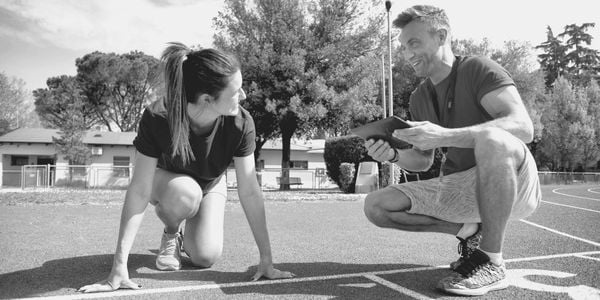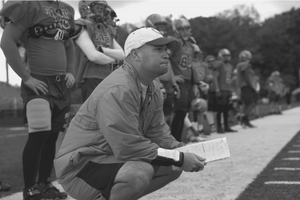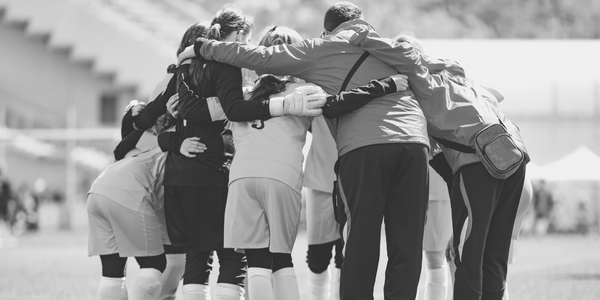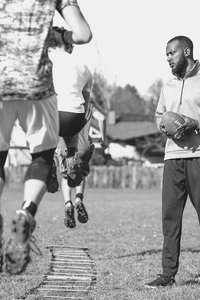75 Questions to Help Student Athletes Choose Their College
There is no one who is in a better position to assist high school student/athletes as they decide...
We believe that all levels of amateur sports should be more than just a game. Athletics should be about education. Don’t get the wrong idea, we train coaches to play to win and to teach athletes to prepare and play to win. Those are lessons that will last long after the games are over.
But, if winning is our only area of emphasis, then we are missing an opportunity to teach much more than only winning. You have a captive audience to teach life, leadership, employability, and teamwork skills.
 Transformational coaches inspire their athletes to contribute to the team in ways that create a growth minded culture that everyone is a part of.
Transformational coaches inspire their athletes to contribute to the team in ways that create a growth minded culture that everyone is a part of.
To be a truly transformational coach, (and walk your talk) you must continually think about:
What am I and our staff doing today to improve the most impactful areas of our program so that we can make this season the most rewarding experience for our athletes that we possibly can?
In order to stay focused, I keep an outline of this document with specific written tasks and goals in my daily planner. (I have attached an example at the end of this article)
Defining and instilling your program’s identity, ideals, values, and culture daily.
 Your first priority is to make sure that you have defined, in writing, a clear direction, philosophy, and identity on which to build every aspect of your program. You have to continue to refine it, teach it, and embody it. The entire coaching staff, players, managers, and all other stakeholders must not only “buy in,” but they must believe in it, feel that they are a part of it, work toward developing it, and feel that it is essential to our success.
Your first priority is to make sure that you have defined, in writing, a clear direction, philosophy, and identity on which to build every aspect of your program. You have to continue to refine it, teach it, and embody it. The entire coaching staff, players, managers, and all other stakeholders must not only “buy in,” but they must believe in it, feel that they are a part of it, work toward developing it, and feel that it is essential to our success.
Athlete development (Area #3 in my seven areas of focus) has the biggest impact on winning and losing. My reason for prioritizing program philosophy entrenched as #1 is that knowing your ideals, value, and culture provides direction for your player development within the scope of the entire program.
Your program identity needs a name. That way it is easy to refer to as an actual living entity—because it is. “The (Insert School Name or Mascot Here) Way.” Is a good place to start. The culture includes your style of play, the intensity, attitude (both on and off the court/field/pool/track/ect.. behavior) and all other intangibles that you stress.
You can use the phrase, “Is that the (name of our school) Way?” when correcting individual or team lapses or poor performance. It focuses more on what is best for the team and program and what the participants believe in, rather than creating an atmosphere of animosity where a coach is perceived as being critical or “picking on” an individual athlete or group of athletes. It is not the coach’s way that we are working for. It is the way of our program and has been built by the efforts of everyone who has ever been a part of it.
In order for that approach to be effective, you must clearly define in writing what “The Way” is for your team and then continually lead and coach in that direction.

If a coach doesn’t have a clearly defined and written vision, it is impossible to achieve the consistency, unity, and intangibles a program needs to succeed from year to year as athletes, assistant coaches, and administrators change.
I believe, that “if you don’t have your philosophy in writing, then you really don’t have a philosophy.”
Area of Focus #2: Organization and Management: Maximizing the Resources at Your Disposal
This bucket can also be defined as “Operations.” Even if your athletic administrator does the purchasing of equipment, facility maintenance, and scheduling for your program, most will welcome and encourage input from their coaches. That isn’t to say that you will get everything you ask for. But, having a list of necessities and another list of “Like to Haves” to share with your Athletic Director is a good place to start a conversation to improve your program.
Taking care of organizational items is not the most exciting part of coaching. However, it will definitely have a negative impact on your program if neglected. It is a responsibility that is better handled proactively rather than reactively. Make sure to stay on top of things such as ordering (or requesting), maintaining and properly storing equipment, uniforms, and other such items.
Develop a written, long-term plan for the funding of big-ticket items. These needs may require more planning and possibly even fundraising, so it is important to keep those items on your list and in front of the administration. The only way to do that is to give it some thought and review on a continual basis. Even smaller “extra” items that go above and beyond the norm and help make your program special require budgeting.
Keep a file of the officials who work your games both at home and on the road. Update it the day after your contest so that you will be less emotional. That way you can make recommendations to your Athletic Administrator as far as who to hire at home. You will also be prepared when it comes time to turn in evaluations to your state association.
Your goal should be to stay on top of operations and deal with them when you want to, rather than waiting until the become urgent distractions and have to deal with them. That will help you stay focused on coaching you team.

Developing your players’ athletic skills and intangibles within your system.
Most coaches would agree that “The team with the best players usually wins.” Granted, there is a certain amount of talent that is natural. It has been my experience that in most coaching situations, the majority of teams on your schedule over a two to four-year period will probably have talent that is similar to yours. Our number one job as coaches is to give them opportunities to learn and grow as people. Our number one job in terms of winning is to develop our players’ abilities, skills, competitiveness, and toughness.
Each year, we develop sport specific and measurable performance goals for our individual skill and sports performance development drills. The players are aware of these goals. These are measurable goals for our drills and use them in and out of season. (One of my favorite videos on Glazier Academies is #16--Athlete Development: Build a Process)
We have a specific plan to develop mental toughness in our athletes that includes:
Develop, implement, and teach systems of team play that fit your players’ (or athletes depending on the sport) strengths and abilities. And, are best suited to beat the teams on your schedule.
This is important, even if you coach an individual sport. You want to be able to set your lineup to maximize the opportunities for your individuals and also to give you a chance to have your highest score as a team.
 For team sports, your system must take into account not only what each player does well, but also your depth.
For team sports, your system must take into account not only what each player does well, but also your depth.
This is something that our staff works on throughout the year, but once we start practices for the upcoming season, it is time to tweak and implement our system of play around the abilities of our players. It is an ongoing process throughout the season. We do not make wholesale adjustments, but will add in wrinkles, or subtract things that aren’t working as well as we thought they would when we included them as a part of our scheme.
This is a philosophical decision that you must make as a coach, My philosophy is that we are going to utilize systems of play and structure our areas that we emphasize in practice that give us the best chance to advance in our season-ending state tournament. We do not change our overall philosophy and style of play from game to game during the regular season. I once (in my first year of coaching) made some large scale adjustments to our tempo for one game and one opponent. It was too much for our athletes to handle. We ended up barely winning against a team that we should have beaten more soundly. Lesson learned!
I refer to this role as team development because not only does it involve our offensive and defensive systems, but it includes team building and team chemistry as well. I just don't think you're going to be able to reach your potential unless there is a cohesion and, camaraderie amongst the players.
Certainly, how well a team gets along has to do with the individual personalities of the players, their past experiences with each other, and the success your team has. But, as coaches we can influence that togetherness by the attitudes that we exhibit and instill in our players, the teambuilding activities that we do, and the emphasis that we put on it.

Assign roles that best fit each player within the system, work to keep them in those roles, and redefine roles as players change or the needs of the team change.
Deciding how each player, each assistant coach, and each manager is going to help the team and then working with that team member to coach them and make them better at that role is crucial to individual and team success.
(Important side note: I have attempted to use the term “participant” throughout this post. I like that term to include not only athletes, but also student managers, student trainers, student camera operators, and all other students that are involved in the operations bucket of the program)
Providing those roles in writing in players and coaches notebooks is a very clear way of giving the direction they need. But, just as important as having a plan to get started is your ability to have a plan to evaluate how each person is performing his or her role, how to keep them within their role, and what to do if they grow out of that role.
Some considerations for establishing the direction of our
 During the season, it is very tough to spend any time on staff development. Just like you ask your players to work on their game during the off-season, the coaching staff also needs to sharpen their skills. We believe that there are five areas for each coach to work on and that coaches should have an individual development plan, just like players have an individual workout plan. The five areas to develop are:
During the season, it is very tough to spend any time on staff development. Just like you ask your players to work on their game during the off-season, the coaching staff also needs to sharpen their skills. We believe that there are five areas for each coach to work on and that coaches should have an individual development plan, just like players have an individual workout plan. The five areas to develop are:
Have a coordinated plan as a staff, so that you have different coaches working in different areas and can share their information so that everyone benefits from each other’s work.
Promoting the program as a whole and the players individually.
Teaching Service
In order to have a complete program, it is an area where you and your staff need to give some thought and some time to. Our philosophy is to teach our participants that:
“You can’t have a good day unless you do something for someone else who cannot do anything in return for you.”
That would include young children, senior citizens, those with disabilities, or random anonymous acts of kindness.
Visits to senior centers, reading days at an elementary school, volunteering to pick up litter in your community, raking leaves, shoveling snow are all things you can do as a team for service.
Promoting Your Program
We don’t do complicated things, but strive to build relationships between our players and our community. We have a simple but up to date web site promoting our program, write a simple pre-season media guide and make copies at school to hand out at games, run summer youth camps, have a father/son one day summer clinic on the Saturday before father’s day, have an autograph night where our players sign our game programs for anyone who is interested.
We schedule all of these a year in advance so that we have the facilities and administrative blessings that we need. My guess is that you can come up with your own.

Public Relations
A big part of your public relations is the way that your athletes and coaches act during a game, contest, or meet. Displaying great sportsmanship while competing hard goes a long way in how your program is perceived.
The second biggest part of public relations is what your coaches and players post on social media, and how they react to things said about them. Not only do negative posts on social media hurt your program as a whole, but they will harm your athletes individually when seen by recruiters and potential employers. Glazier Academies has an outstanding video on developing your guidelines for how social media is used in your program.
I do understand as I write this that it is a lot of information. It is a lot of great information! I can say that because I took these ideas from other coaches and synthesized them for you.
If you feel that you can’t implement them all at once, that is fine. Pick the one area that that you feel is most critical for you and get to work as a coaching staff to build your processes.
The key to your success in these seven areas, and ultimately your team and program is your ability to visualize what you want in each of the seven key result areas. Next, put in writing, your long range, yearly, monthly, and daily goals and tasks. Finally, work systematically to implement them through the work of everyone in your program.
We, at Glazier Academies, wish you the best and would love to be a part of your journey toward building your program into one that your participants will never forget!
One of the best ways to get the best ideas for you to incorporate into all of your efforts to improve every day is to learn from coaches who have proven ways to get better in all areas of your program.
Glazier Academies gives you access to those coaches. Click here to read more about the best soft skills training that is available for every coach of every sport in your school.
There is no one who is in a better position to assist high school student/athletes as they decide...
In 40 years of working with coaches, we haven’t met very many who don’t work hard. Most of the ones...
The athletic triangle between coaches--players--parents is a challenging system to balance. In...